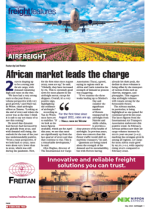Ongoing disruption in the Red Sea is driving up airfreight volumes, as shippers worldwide are increasingly choosing to f ly their cargo instead.According to Glyn Hughes, director general of The International Air Cargo Association (Tiaca), it is a situation that was not foreseen as ongoing attacks by Houthi rebels on merchant ships are seeing fewer and fewer vessels traverse the Suez Canal.“With carriers opting to sail around the Cape, it has added significant delays to the supply chain,” he said. “Ocean freight from Asia to Europe, for example, takes at least two weeks longer with this rerouting. It is not only adding time to the movement of cargo but also increasing costs, from fuel to operations. In some cases, the price of a TEU is more than double.”He noted that secondary challenges were also arising, such as the return of empty containers. Some reports indicate it could take as long as four weeks to get them back into the system. “In Asia, this is becoming a challenge, and due to the lack of containers, cargo cannot get out of manufacturing sites to the ports in the reg ion.”All this has made airfreight a very attractive option. It not only minimises the delays experienced but, from a cost perspective, it’s becoming increasingly competitive.Hughes said the uncertainty of the ocean freight environment was driving up demand for air cargo, as shippers were opting for airfreight to minimise delays as much as possible.According to Wenwen Zhang, an airfreight market analyst at Xeneta, dynamic load factors for airfreight are up on almost every regional corridor compared to 2023. “We are definitely seeing the impact of the Red Sea situation. The ongoing conf lict is proving to be a strong push behind the load factor. It is, of course, affecting some trade lanes more than others. For example, if we look at the Asia-Pacific to Europe corridor, we see load factors up by 9% compared to last year. The overall load factor for this trade is in the mid-80% range. If we draw a line between a buyer's and a seller's market, it is clear that this trade lane has shifted from a weak buyer's market to a strong seller's market. This shift is completely changing the dynamics and is definitely pushing up rates.”Load factors are also significantly up on the Middle East and Central Asia lane to Europe by more than 13% and to America by 18%.“The geopolitical situation is having a very clear impact on ocean logistics, which in turn is affecting the airfreight sector. In practical terms, this means shippers have been frantically seeking airfreight capacity to ensure timely delivery of goods into markets such as Europe and North America for the summer.”With schedule reliability for ocean carriers currently at around 42%, analysts are predicting no change to the current situation and foresee demand for airfreight increasing during the last six months of the year.“As vessels continue to detour around the Cape and uncertainty prevails, we will continue to see goods typically moved via sea transported by air,” said Zhang.

